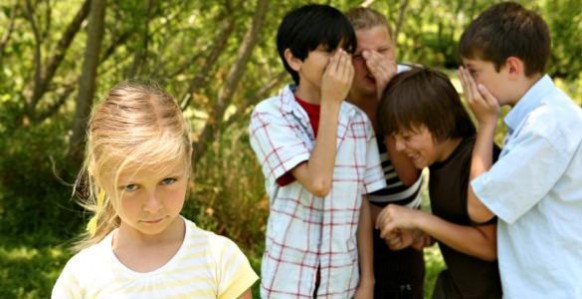My child is a bully! What do I do?
 Schooladvisor Team
Schooladvisor TeamIt usually starts with a phone call from the school: Your child's in trouble for bullying. "Ninety-nine percent of parents will say, 'No way, not my kid' and get defensive". But the truth is every kid is capable of bullying, even the kid you think is an angel. So why do kids bully?

One reason is when popular and powerful children use bullying to maintain their power and popularity. The other reason is when children who experience a sense of deprivation feel entitled to bully other kids; that is, 'I've been dealt a bad hand, so the rules don't apply to me.' or 'I've been picked on, so I'll get to them before they get to me. Kids also observe examples of bullying behavior every day through media, politics, TV reality shows, other kids at school, and even family dynamics. They may not understand that such behaviors are not acceptable anywhere.
Just take a deep breath, gather details about what exactly transpired, and let the school know that you want to work together for a positive outcome. At the same time, make sure that your child is treated fairly regarding school discipline. Assess your child's actions without rushing to judgment and focus on understanding the behavior that's involved before deciding on the appropriate consequences. The good news is that kids can unlearn bullying behaviors, and you can help them change their ways.
There are 4 types of bullying
Verbal Bullying
 What It Is: Verbal bullying, or bullying with cruel spoken words, involves ongoing name-calling, threatening, and making disrespectful comments about someone's attributes (appearance, religion, ethnicity, disability, sexual orientation, etc.).Example: When a child says to another child, "You're really, really fat and so is your mom."How to Spot the Signs: Children may withdraw, become moody, or show a change in appetite. They may tell you something hurtful that someone said about them and ask you if you think it's true.
What It Is: Verbal bullying, or bullying with cruel spoken words, involves ongoing name-calling, threatening, and making disrespectful comments about someone's attributes (appearance, religion, ethnicity, disability, sexual orientation, etc.).Example: When a child says to another child, "You're really, really fat and so is your mom."How to Spot the Signs: Children may withdraw, become moody, or show a change in appetite. They may tell you something hurtful that someone said about them and ask you if you think it's true.
Physical Bullying
What It Is: Physical bullying, or bullying with aggressive physical intimidation, involves repeated hitting, kicking, tripping, blocking, pushing, and touching in unwanted and inappropriate ways.Example: A child gets his pants pulled down on the playground at lunchtime.How to Spot the Signs: Many children don't tell their parents when it happens, so watch for possible warning signs like unexplained cuts, scratches, bruises, missing or damaged clothes, frequent complaints of headaches and stomachaches.
Relational Bullying

What It Is: Relational bullying, or bullying with exclusionary tactics, involves deliberately preventing someone from joining or being part of a group, whether it's at a lunch table, game, sport, or social activity. New research shows relational bullying starts as young as 3 years old!Example: A group of girls in dance class talking about a weekend sleepover and sharing pictures, treating the one uninvited child as if she were invisible.How to Spot the Signs: Watch for mood changes, withdrawal from peer groups, and a shift towards being alone more than usual. Girls are more likely than boys to experience social exclusion, nonverbal, or emotional intimidation. The pain can be as strong as physical bullying and last even longer.
Cyberbullying

What It Is: Cyberbullying, or bullying in cyberspace, involves harassing someone by spreading mean words, lies, false rumors through e-mails, text messages, and social media posts. Sexist, racist, and homophobic messages create a hostile atmosphere, even when not directly targeting your child.Example: When someone tweets or posts, "Kayden is a total loser. Why is anyone even hanging out with him? He's so gay."How to Spot the Signs: Watch to see if your child spends more time online (visiting social media pages or texting) but appears to be sad and anxious afterward. Even though she's reading painful things on her computer, tablet, or phone, this may be her only social outlet. Also take note if she has trouble sleeping, begs to stay home from school, or withdraws from activities she once loved.
What to Do If Your Child Is Bullying Others

Acknowledge the Behavior
Sit down with your child, speak in a calm, firm tone, ask him what happened and why he or she behaved in that manner. Be a good listener and avoid blame. Kids need to understand that it's okay to admit they made a mistake. Ask questions to help him or her understand how their behavior affects others: "Is what you did respectful? Did it hurt someone? Would you want someone to do that to you?" Emphasize fair treatment of all people by saying, 'We don't behave that way in this family because we respect other people, and we don't want other people to treat us that way'.
Focus on Consequences
Help your child understand that she is accountable for her actions. Outline and follow through with consequences for bullying behavior. Write them out, review them once a week, and enforce them. Depending on the circumstances, you can eliminate something your child cherishes so the consequence will be significant, such taking away your child's cell phone, eliminating or reducing TV or video game time, or preventing participation in a social outing. Or, better yet, turn the bullying incident into a teachable moment by discussing positive ways your child can handle future situations that lead to good consequences. Have your child write a paragraph describing what it would feel like to be in the other child's shoes or write an apology letter.

Be Proactive About Working With the School
School personnel work best when they see that parents sincerely want to improve the situation. Don't feel you'll be judged as a bad parent. It's hard raising kids, and it's not a failure to ask for help. So, don't be afraid to work with the school to help your child learn behaviors that are constructive. Start with your child's teacher and then meet with the principal and counselor to come up with a plan to help your child stop bullying. Ask if counseling or other community resources are available to help your child. Stay in close touch with the school to see if your child's behavior improves.
Build Social and Emotional Skills
Empower your child to build his or her skills for resolving conflicts and handling tough situations. Social and emotional learning includes self-awareness, self-management, resilience, social agility, and responsible decision-making. Look for after-school programs and extracurricular activities that can provide new settings to help develop ways to build positive relationships. Improving these skills now, while your child is in elementary school, will be a lifelong gift.
Recent Articles
- What Should You Be Looking for in a Preschool?
- HELP Education Group Unveils New Sports Oval in Subang 2 Campus
- Exploring the Homeschooling Path: What Parents Need to Know Before Taking the Leap
- More Parents Are Now Opting for International Schools in Malaysia
- AISM Students Who Dream Big and Build Bigger

